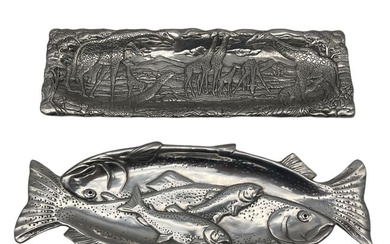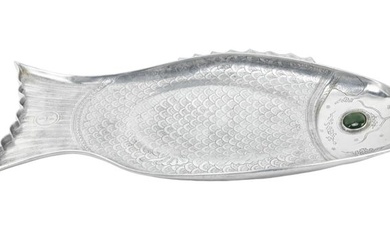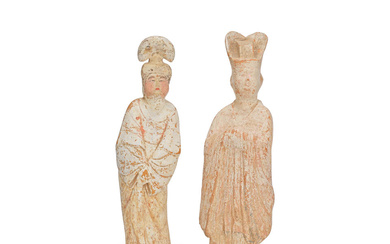A LARGE PAINTED RED POTTERY FIGURE OF A...
A LARGE PAINTED RED POTTERY FIGURE OF A COURT LADY, TANG DYNASTY
China, 618-907. The lady is shown standing with her body elegantly swayed to one side as her head is raised inquisitively towards the visitor. Her hands, held in front of her chest, are distinctively modeled in fine detail whereas the voluminous sleeves of her robe fall down in voluminous folds. Her hair is dressed in an elaborate coiffure. Remnants of pigment.
Provenance: An Austrian private collection. Galerie Zacke, Vienna, May 27th, 2003. Dr. Mons Fischer, acquired from the above for EUR €11,132. A copy of the invoice from Galerie Zacke, Vienna, May 27th, 2003, is accompanying this lot. A seasoned private collector of modern and contemporary art, Dr. Mons Fischer has also acquired fine Chinese works of art since the 1980s, eventually building one of the most important collections of its kind in Austria.
Condition: Some repair and touchups as generally expected from Tang dynasty excavations. Losses, fissures and encrustations. Three drilled holes from sample-taking. Overall very good condition.
Scientific Report: A thermoluminescence analysis report issued by Oxford Authentication on February 11th, 2020, based on sample number C120a59, sets the firing date of three samples taken at 900 - 1500 years ago. A copy of the report, issued by Oxford Authentication, is accompanying this lot. Weight: 4.4 kgDimensions: Height 55.5 cmThis
elegant figure, beautifully modeled with carefully incised lines that suggest the folds of the garment, is a particularly large and charming example of the court ladies that became fashionable in the second half of the Tang dynasty. The reign of Emperor Ming Huang seems to have heralded the growth in popularity of a more generous female form and the adoption of less structured, flowing robes. This change in style has traditionally been attributed to the influence of the emperor's adored concubine Yang Guifei, who was reported to have had a rather voluptuous figure. Yang Guifei was held partly responsible for the circumstances that led to the An Lushan rebellion of AD 756, and she was executed by the accompanying troops as she and the emperor fled to Sichuan. The Emperor's grief at her loss was immortalized in one of China's best known literary works, The Song of Eternal Regret. However, excavated figures suggest that this fashion was already coming to prominence by the time that Yang Guifei won the emperor's admiration.
In addition to their robes, the hairstyles of these figures also differ from those of their slender predecessors. While the latter tended to have their hair drawn back from the face and then arranged in one or two elaborate knots, the plumper ladies, like the current figure, tend to have softer hair styles. The hair is much fuller, framing the upper part of the face and is tied in a loose arrangement on top.
Literature comparison: The figures of this type usually hold their hands in front of them, in order to provide a more graceful arrangement of their sleeves. Some have their hands completely hidden as can be seen in three of the figures from the Schloss Collection. See J. Baker, Seeking Immortality - Chinese Tomb Sculpture from the Schloss Collection, Bowers Museum of Cultural Art, Santa Ana, 1996, p. 34, no. 17 Others among these figures hold a pet animal or bird, as in the case of the figure with a small pug dog in the Museum of Oriental Ceramics, Osaka, illustrated by G. Hasebe and M. Sato, Sekai toji zenshu, 11 Tang, Tokyo, 1976, no. 29, or the figure gently cradling a songbird in her hand, Seeking Immortality, op. cit, p. 34, no. 17, second from the right. A very few of the figures hold a small child, as in the case of a mother and child group excavated from a tomb dated to AD 744 near Xi'an. See E. Schloss, Ancient Chinese Ceramic Sculpture from Han through Tang, vol. 1, Stamford, 1977, p. 42, fig. 7
.Auction result comparison: Compare with a closely related pottery figure of a lady at Christies New York in Important Chinese Ceramics and Works of Art, 13 September 2019, lot 835, sold for USD $62,500.大
型彩繪侍女陶俑,唐代中國,618-907。如圖所示,侍女身體優雅地偏向一側,她的頭向訪客好奇地抬起。雙手在胸前,細節精美,造型獨特,而長袍的袖子則垂下褶皺。 她的頭髮整齊地梳著。
殘留的顏料。來源:一個奧地利私人老收藏。維也納Zacke藝廊,2003年5月27日。Dr. Mons Fischer購於上述藝廊,成交價EUR €11.132。隨附發票複印件。Dr. Mons
Fischer是一位經驗豐富的現代和當代藝術私人收藏家,從1980年代開始收藏中國藝術品,最終在奧地利建立了此類藏品最重要的收藏之一。品相:唐代考古普遍預期的一些維修和修整。 缺損,裂縫和結殼。 測試所需的樣品採集產生的三個鑽孔。
總體狀況很好。隨附牛津熱釋光測試檢測證書拷貝重量:4.4
公斤尺寸:高55.
5厘米拍賣結果比較:一件相近侍女陶俑2019年9月13日紐約佳士得《重要中國陶瓷和工藝品》拍號835,成交價USD $62
.500。 Automatically translated by DeepL. To see the original version, click here.
View it on
Estimate
Time, Location
Auction House
A LARGE PAINTED RED POTTERY FIGURE OF A COURT LADY, TANG DYNASTY
China, 618-907. The lady is shown standing with her body elegantly swayed to one side as her head is raised inquisitively towards the visitor. Her hands, held in front of her chest, are distinctively modeled in fine detail whereas the voluminous sleeves of her robe fall down in voluminous folds. Her hair is dressed in an elaborate coiffure. Remnants of pigment.
Provenance: An Austrian private collection. Galerie Zacke, Vienna, May 27th, 2003. Dr. Mons Fischer, acquired from the above for EUR €11,132. A copy of the invoice from Galerie Zacke, Vienna, May 27th, 2003, is accompanying this lot. A seasoned private collector of modern and contemporary art, Dr. Mons Fischer has also acquired fine Chinese works of art since the 1980s, eventually building one of the most important collections of its kind in Austria.
Condition: Some repair and touchups as generally expected from Tang dynasty excavations. Losses, fissures and encrustations. Three drilled holes from sample-taking. Overall very good condition.
Scientific Report: A thermoluminescence analysis report issued by Oxford Authentication on February 11th, 2020, based on sample number C120a59, sets the firing date of three samples taken at 900 - 1500 years ago. A copy of the report, issued by Oxford Authentication, is accompanying this lot. Weight: 4.4 kgDimensions: Height 55.5 cmThis
elegant figure, beautifully modeled with carefully incised lines that suggest the folds of the garment, is a particularly large and charming example of the court ladies that became fashionable in the second half of the Tang dynasty. The reign of Emperor Ming Huang seems to have heralded the growth in popularity of a more generous female form and the adoption of less structured, flowing robes. This change in style has traditionally been attributed to the influence of the emperor's adored concubine Yang Guifei, who was reported to have had a rather voluptuous figure. Yang Guifei was held partly responsible for the circumstances that led to the An Lushan rebellion of AD 756, and she was executed by the accompanying troops as she and the emperor fled to Sichuan. The Emperor's grief at her loss was immortalized in one of China's best known literary works, The Song of Eternal Regret. However, excavated figures suggest that this fashion was already coming to prominence by the time that Yang Guifei won the emperor's admiration.
In addition to their robes, the hairstyles of these figures also differ from those of their slender predecessors. While the latter tended to have their hair drawn back from the face and then arranged in one or two elaborate knots, the plumper ladies, like the current figure, tend to have softer hair styles. The hair is much fuller, framing the upper part of the face and is tied in a loose arrangement on top.
Literature comparison: The figures of this type usually hold their hands in front of them, in order to provide a more graceful arrangement of their sleeves. Some have their hands completely hidden as can be seen in three of the figures from the Schloss Collection. See J. Baker, Seeking Immortality - Chinese Tomb Sculpture from the Schloss Collection, Bowers Museum of Cultural Art, Santa Ana, 1996, p. 34, no. 17 Others among these figures hold a pet animal or bird, as in the case of the figure with a small pug dog in the Museum of Oriental Ceramics, Osaka, illustrated by G. Hasebe and M. Sato, Sekai toji zenshu, 11 Tang, Tokyo, 1976, no. 29, or the figure gently cradling a songbird in her hand, Seeking Immortality, op. cit, p. 34, no. 17, second from the right. A very few of the figures hold a small child, as in the case of a mother and child group excavated from a tomb dated to AD 744 near Xi'an. See E. Schloss, Ancient Chinese Ceramic Sculpture from Han through Tang, vol. 1, Stamford, 1977, p. 42, fig. 7
.Auction result comparison: Compare with a closely related pottery figure of a lady at Christies New York in Important Chinese Ceramics and Works of Art, 13 September 2019, lot 835, sold for USD $62,500.大
型彩繪侍女陶俑,唐代中國,618-907。如圖所示,侍女身體優雅地偏向一側,她的頭向訪客好奇地抬起。雙手在胸前,細節精美,造型獨特,而長袍的袖子則垂下褶皺。 她的頭髮整齊地梳著。
殘留的顏料。來源:一個奧地利私人老收藏。維也納Zacke藝廊,2003年5月27日。Dr. Mons Fischer購於上述藝廊,成交價EUR €11.132。隨附發票複印件。Dr. Mons
Fischer是一位經驗豐富的現代和當代藝術私人收藏家,從1980年代開始收藏中國藝術品,最終在奧地利建立了此類藏品最重要的收藏之一。品相:唐代考古普遍預期的一些維修和修整。 缺損,裂縫和結殼。 測試所需的樣品採集產生的三個鑽孔。
總體狀況很好。隨附牛津熱釋光測試檢測證書拷貝重量:4.4
公斤尺寸:高55.
5厘米拍賣結果比較:一件相近侍女陶俑2019年9月13日紐約佳士得《重要中國陶瓷和工藝品》拍號835,成交價USD $62
.500。 Automatically translated by DeepL. To see the original version, click here.







